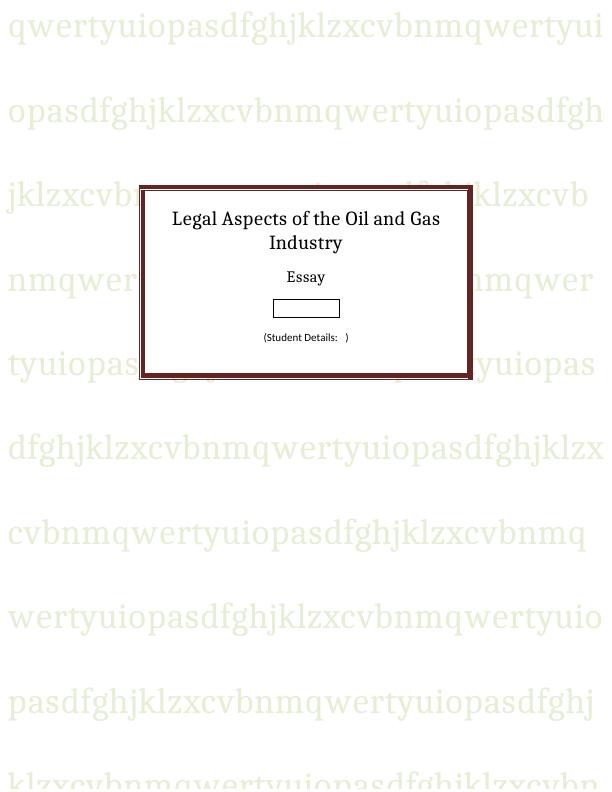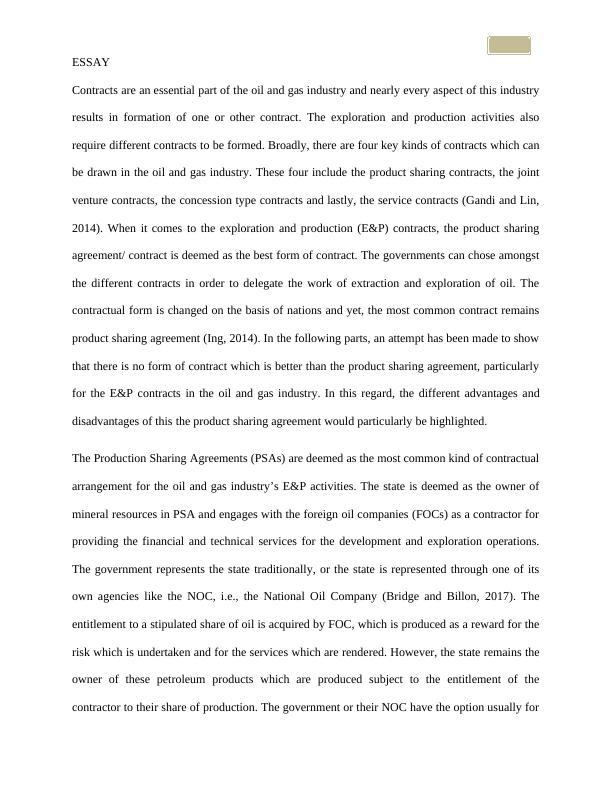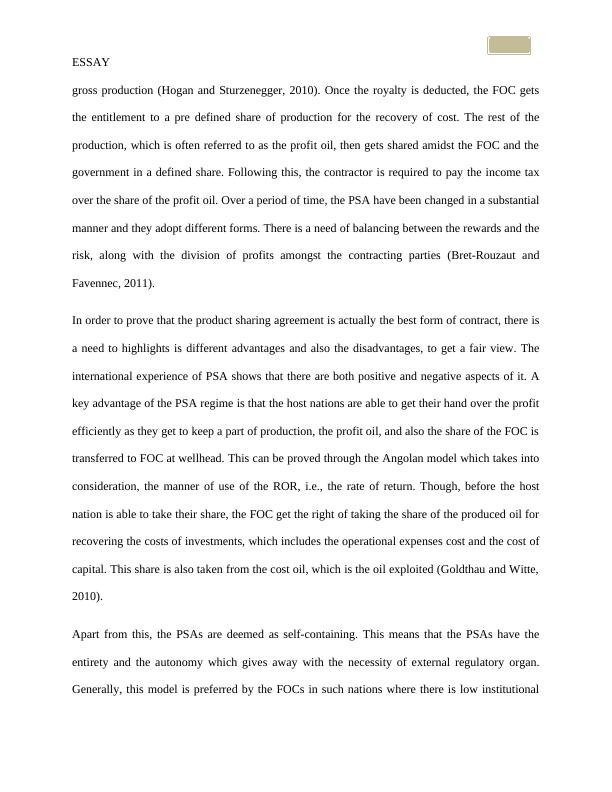POG220 Legal Aspects of the Oil and Gas Industry
11 Pages2787 Words194 Views
GSM London
Legal Aspects of the Oil and Gas Industry (POG220)
Added on 2020-05-04
POG220 Legal Aspects of the Oil and Gas Industry
GSM London
Legal Aspects of the Oil and Gas Industry (POG220)
Added on 2020-05-04
ShareRelated Documents
qwertyuiopasdfghjklzxcvbnmqwertyuiopasdfghjklzxcvbnmqwertyuiopasdfghjklzxcvbnmqwertyuiopasdfghjklzxcvbnmqwertyuiopasdfghjklzxcvbnmqwertyuiopasdfghjklzxcvbnmqwertyuiopasdfghjklzxcvbnmqwertyuiopasdfghjklzxcvbnmqwertyuiopasdfghjklzxcvbnmqwertyuiopasdfghjklzxcvbnmqwertyuiopasdfghjklzxcvbnmqwertyuiopasdfghjklzxcvbnmqwertyuiopasdfghjklzxcvbnLegal Aspects of the Oil and GasIndustryEssay(Student Details: )

ESSAYContracts are an essential part of the oil and gas industry and nearly every aspect of this industryresults in formation of one or other contract. The exploration and production activities alsorequire different contracts to be formed. Broadly, there are four key kinds of contracts which canbe drawn in the oil and gas industry. These four include the product sharing contracts, the jointventure contracts, the concession type contracts and lastly, the service contracts (Gandi and Lin,2014). When it comes to the exploration and production (E&P) contracts, the product sharingagreement/ contract is deemed as the best form of contract. The governments can chose amongstthe different contracts in order to delegate the work of extraction and exploration of oil. Thecontractual form is changed on the basis of nations and yet, the most common contract remainsproduct sharing agreement (Ing, 2014). In the following parts, an attempt has been made to showthat there is no form of contract which is better than the product sharing agreement, particularlyfor the E&P contracts in the oil and gas industry. In this regard, the different advantages anddisadvantages of this the product sharing agreement would particularly be highlighted.The Production Sharing Agreements (PSAs) are deemed as the most common kind of contractualarrangement for the oil and gas industry’s E&P activities. The state is deemed as the owner ofmineral resources in PSA and engages with the foreign oil companies (FOCs) as a contractor forproviding the financial and technical services for the development and exploration operations.The government represents the state traditionally, or the state is represented through one of itsown agencies like the NOC, i.e., the National Oil Company (Bridge and Billon, 2017). Theentitlement to a stipulated share of oil is acquired by FOC, which is produced as a reward for therisk which is undertaken and for the services which are rendered. However, the state remains theowner of these petroleum products which are produced subject to the entitlement of thecontractor to their share of production. The government or their NOC have the option usually for

ESSAYparticipating in the different features of the E&P process. Along with this, the PSAs provide forthe joint committees to be established in a frequent manner in which there is representation ofparties and the operations are monitored (Mikesell, 2016). In 1966, the PSAs were introduced for the very first time in Indonesia (Duval et al, 2009). Oncethe independence was attained, a nationalistic feeling was running high and the foreigncompanies, along with their concessions transformed into a bull’s eye for hostility and criticism.As a response to this, the government denied the grant of new concessions. For overcoming thesucceeding stagnation in the oil development, which was deemed as a drawback for the firms ofthe nation and of other nations, the new petroleum legislation was brought forward. The PSAsbecame acceptable as the government upheld the nation ownership of the resources. Even thoughthe same was initially opposed by the companies, as they did not want to invest their capital in anenterprise which they could not manage. Even a more important fact was that the FOCs did notwant to form a precedent which could have an impact over their concessions at some other place.Hence, the very first PSA was signed by the independent FOCs who depicted a higherwillingness of compromising and accepting the terms which the giants had turned down. Thiswas a very nice opportunity for such independents to gain access to high quality crude oil andbreak the dominance of industry giants (Bindemann, 1999). The PSAs are differentiated from the other forms of contracts, in two prominent ways. The firstmanner is that the FOC conducts the complete exploration risk. Where no oil is found, thecompany does not get any kind of compensation. And secondly, the government is the owners ofthe installations and the resources. When the very basic form of any PSA is analysed, four keyproperties are highlighted. The royalty is paid by the foreign partner to the government on the

ESSAYgross production (Hogan and Sturzenegger, 2010). Once the royalty is deducted, the FOC getsthe entitlement to a pre defined share of production for the recovery of cost. The rest of theproduction, which is often referred to as the profit oil, then gets shared amidst the FOC and thegovernment in a defined share. Following this, the contractor is required to pay the income taxover the share of the profit oil. Over a period of time, the PSA have been changed in a substantialmanner and they adopt different forms. There is a need of balancing between the rewards and therisk, along with the division of profits amongst the contracting parties (Bret-Rouzaut andFavennec, 2011). In order to prove that the product sharing agreement is actually the best form of contract, there isa need to highlights is different advantages and also the disadvantages, to get a fair view. Theinternational experience of PSA shows that there are both positive and negative aspects of it. Akey advantage of the PSA regime is that the host nations are able to get their hand over the profitefficiently as they get to keep a part of production, the profit oil, and also the share of the FOC istransferred to FOC at wellhead. This can be proved through the Angolan model which takes intoconsideration, the manner of use of the ROR, i.e., the rate of return. Though, before the hostnation is able to take their share, the FOC get the right of taking the share of the produced oil forrecovering the costs of investments, which includes the operational expenses cost and the cost ofcapital. This share is also taken from the cost oil, which is the oil exploited (Goldthau and Witte,2010). Apart from this, the PSAs are deemed as self-containing. This means that the PSAs have theentirety and the autonomy which gives away with the necessity of external regulatory organ.Generally, this model is preferred by the FOCs in such nations where there is low institutional

End of preview
Want to access all the pages? Upload your documents or become a member.
Related Documents
Comparing Service Contract and Petroleum Sharing Agreement in Nigerialg...
|9
|2263
|44
Contracting methods in oil and gas industrylg...
|7
|1980
|160
Concession for Exploration and Production | Reportlg...
|9
|2657
|52
Report on Fiscal System Structure of Petroleum Rights and Contract Agreementslg...
|7
|1276
|49
Stabilisation and Renegotiation Clauses in Transnational Petroleum Agreementslg...
|25
|9249
|421
Sustainability Issues in Petroleum Contractinglg...
|23
|6520
|412
